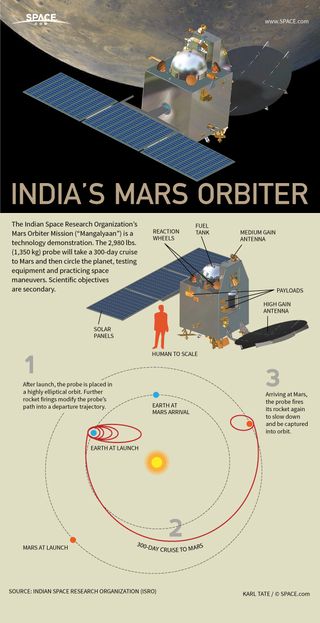How India's First Mars Mission Works (Infographic)

The Indian Space Research Organization’s Mars Orbiter Mission (“Mangalyaan”) is a technology demonstration. The 2,980-pound (1,350 kilograms) probe will take a 300-day cruise to Mars and then circle the planet, testing equipment and practicing space maneuvers. Scientific objectives are secondary.
After launch, the probe is placed in a highly elliptical orbit around Earth. Further rocket firings modify the probe’s path into a departure trajectory.
The cruise to Mars lasts 300 days. Arriving at Mars, the probe fires its rocket again to slow down and be captured into orbit.
India’s Mars probe is expected to spend six to ten months in orbit, studying the Red Planet’s environment, snapping photos of its surface and searching for methane in the atmosphere, which might be an indicator of life.
Join our Space Forums to keep talking space on the latest missions, night sky and more! And if you have a news tip, correction or comment, let us know at: community@space.com.
Get the Space.com Newsletter
Breaking space news, the latest updates on rocket launches, skywatching events and more!

Karl's association with Space.com goes back to 2000, when he was hired to produce interactive Flash graphics. From 2010 to 2016, Karl worked as an infographics specialist across all editorial properties of Purch (formerly known as TechMediaNetwork). Before joining Space.com, Karl spent 11 years at the New York headquarters of The Associated Press, creating news graphics for use around the world in newspapers and on the web. He has a degree in graphic design from Louisiana State University and now works as a freelance graphic designer in New York City.
